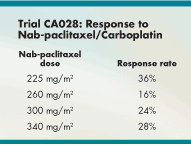First-line Nab-paclitaxel Shows Efficacy in NSCLC Trials
In early studies, the albumin-bound 130-nm formulation of paclitaxel (nab-paclitaxel, Abraxane) has shown promise in first-line treatment of non-small-cell lung cancer (NSCLC)
• NEW YORK In early studies, the albumin-bound 130-nm formulation of paclitaxel (nab-paclitaxel, Abraxane) has shown promise in first-line treatment of non-small-cell lung cancer (NSCLC). Speaking at a presentation held in conjunction with the Chemotherapy Foundation Symposium XXIV, Chandra Belani, MD, highlighted current investigations of nab-paclitaxel as single-agent and combination therapy for NSCLC. Dr. Belani is professor of medicine and co-director of the Lung and Thoracic Malignancies Program at the University of Pittsburgh Cancer Institute.
The presentation was supported by an educational grant from Abraxis Oncology, the developer of Abraxane. The agent is FDA approved as second-line treatment of metastatic breast cancer.
Current Trials
Dr. Belani reviewed several completed and ongoing investigations of nab-paclitaxel as first-line therapy in NSCLC:
• In a multicenter phase II study, Mark Green, MD, of the Medical University of South Carolina, Charleston, and colleagues reported what Dr. Belani described as "provocative early data" in an evaluation of single-agent first-line nab-paclitaxel at 260 mg/m2 every 3 weeks in NSCLC (Ann Oncol 17:1263-1268, 2006). In 43 enrolled patients, overall response was 16%, and disease control rate was 49%. Median time to progression (TTP) was 6 months, and median survival was 11 months.

Nearly all patients (95%) were treated without dose reduction. No grade 4 treatment-related toxicities occurred. Two patients discontinued treatment because of a grade 3 toxicity (neuropathy in one patient, fatigue in the other).
• In a phase I dose-finding study, Naiyer A. Rizvi, MD, of Memorial Sloan-Kettering Cancer Center, and colleagues administered weekly nab-paclitaxel to chemonaive patients with stage IV NSCLC. Patients received nab-paclitaxel at 100, 125, 150, and 175 mg/m2 on days 1, 8, and 15 every 28 days. Dose-limiting toxicities occurred with the 150 mg/m2 dose, and the MTD for phase II was determined to be 125 mg/m2.
In the follow-up phase II study by Rizvi et al in 40 patients with untreated stage IV NSCLC (48% men), patients received a median of four cycles (range, 1 to 14) of nab-paclitaxel at 125 mg/m2 on the phase I schedule. Twelve patients had either a complete response (CR) (1) or a partial response (PR) (11), for an overall response rate of 30%. Median TTP was 4.9 months and median time to death, 10.9 months. No febrile neutropenia or grade 4 hematologic toxicity occurred. Sensory neuropathy and fatigue were the most common adverse events.
• CA028, a European-Asian open-label dose-escalation four-cohort study of combination therapy with nab-paclitaxel/carboplatin in chemonaive stage IIIB/IV NSCLC, was initiated in March 2005 and is closed to accrual. A total of 100 patients (25 in each cohort) have been enrolled. All patients received carboplatin to AUC 6 every 3 weeks. In each of four cohorts, patients received a different dose of nab-paclitaxel: 225, 260, 300, or 340 mg/m2.
The overall response rate was 26%, and an additional 36% had stable disease. The greatest response occurred at the 225 mg/m2 dose (see Table). The rate of sensory neuropathy ranged from 8% at the 225 mg/m2 dose to 24% at the 340 mg/m2 dose.
• Craig Reynolds, MD, and colleagues from the US Oncology Network conducted a phase II 50-patient study in advanced chemonaive NSCLC of nab-paclitaxel at 300 mg/m2 and carboplatin plus bevacizumab (Avastin), with encouraging results. Among 42 evaluable patients, PR was seen in 31%, stable disease in 57%, and unconfirmed PR in 10%, for a 98% overall disease control rate. The most common toxicities were neutropenia (41%), neuropathy (9%), pulmonary emboli (6%), nausea/vomiting (6%), hemoptysis (6%, 1 fatal), and dyspnea (6%).
In a presentation at the Chemotherapy Foundation Symposium, Dr. Reynolds reported that the neuropathy observed was more readily reversible than that seen with conventional paclitaxel.
At the Chemotherapy Foundation Symposium, Frank Anthony Greco, MD, and colleagues from the National Oncology Alliance Online Collaborative Oncology Group reported strong clinical outcomes in a phase II open-label trial of first-line nab-paclitaxel (100 mg/m2 weekly on days 1, 8, and 15 of a 28-day cycle) plus carboplatin to AUC 6 (on day 1) in 56 patients with chemonaive stage IIIB/IV NSCLC.
The response rate was 48% (27 of 56 patients) or 54% in the 50 evaluable patients. A total of 17 patients had stable disease lasting at least 12 weeks. Median time to progression was 30 weeks. Toxicity was as expected (neutropenia 27%/23% grade 3-4, thrombocytopenia 23%/2% grade 3-4, peripheral sensory neuropathy 2% grade 3). In most cases, neuropathy improved in less than 1 week.
There is emerging evidence, Dr. Belani noted, that "the optimal dose of nab-paclitaxel with carboplatin is probably 100 mg/m
2
/wk, on the day 1, 8, and 15 every-28-day schedule." Studies to date in NSCLC indicate that weekly nab-paclitaxel may have a better therapeutic index than an every-3-week regimen, he said.
Phase III Study
Protocol CA031, a phase III study of Abraxane in NSCLC, will be initiated soon, Dr. Belani said. The protocol calls for patients to receive either nab-paclitaxel at 100 mg/m2 weekly plus carboplatin to AUC 6 every 3 weeks or standard paclitaxel at 225 mg/m2 every 3 weeks plus carboplatin to AUC 6 every 3 weeks.